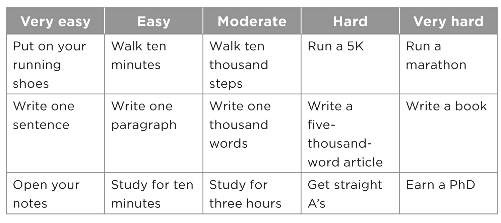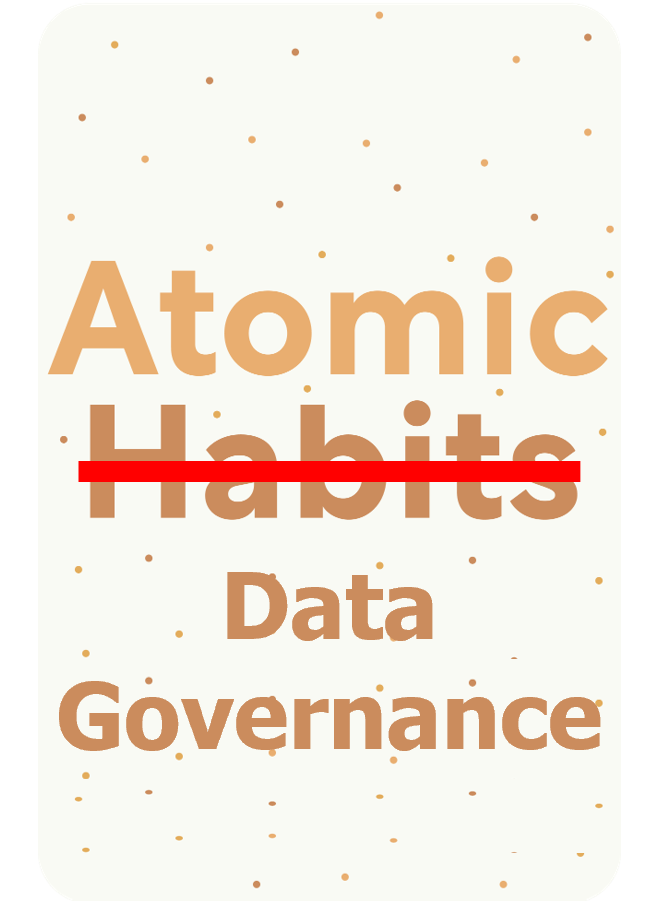
Ever struggled with keeping a New Year's resolution? Is the gap between planning and doing often too wide in your case? Well, you're not alone. As we progress deeper into 2024, it's more than likely that most of us have already let our New Year's resolutions slip away. But what if it didn't have to be that way? What if there was a method to approach your resolutions—or any goal for that matter—with a mindset that significantly boosts your chances of success?
While this article might not hold the secret formula to perfecting your diet or exercise regime, it aims to use similar principles to achieve something else. Let's finally make Data Governance tangible for you and your organization.
Why Do Good Intentions Often Fail
Let us start with something many of us can relate to. We all grasp the basics: “To lose weight, consume less and move more”. Yet knowing is not the same as doing. The issue? A foundation built on moody ground. This principle applies not just to personal health but is strikingly relevant to Data Governance.
Many organizations understand the necessity of Data Governance. They complain about poor data quality, lack a comprehensive view of their data landscape, and find departments misaligned in their understanding of data. They all have the same objective: high-quality, well-organized, accessible, and standardized data in a landscape of clear roles and responsibilities.
Yet, despite recognizing the need, Data Governance can appear daunting and can often be perceived as a limitation of data freedom rather than a facilitator of decision-making.
Small Steps for Significant Impact
What if the path to effective Data Governance is more straightforward than most companies think? Inspired by "Atomic Habits" by James Clear, we explore how incremental actions can lead to monumental improvements in managing your organization's data.
The question of "How to Start" with Data Governance puzzles many organizations. Before we dive deep into the principles that can transform your Data Governance strategy, let's first have a look at what we usually propose, as the “best-practice” approach to its implementation:
- Align with Business Objectives: This is the first crucial point that many individuals tend to forget about: if you want to secure the success of your initiative, start by identifying how Data Governance can support and drive the goals of your company. Let’s say your organization’s objective is to excel in customer support. Data Governance efforts should focus on the reliability and accuracy of the tools and the data used by customer service.
- Perform a Readiness Assessment: Once the Data Governance objectives are aligned with the ones of your company, you should evaluate your organization's maturity, change management capabilities, and readiness to collaborate. Understanding your maturity and readiness level is essential for effective planning and execution. It will allow us to adopt the appropriate techniques for addressing specific challenges. Considering the example of customer support improvement, you will want to conduct workshops with the customer support team. Try to identify gaps in their current data literacy level and ability to use data and the tools in their daily operations.
- Perform a Discovery for Business Alignment: Now it is time to understand how data flows within your organization and align it with your business processes. A clear understanding of your current state, your desired future state, and the steps required to bridge the gap is foundational for progress. Mapping out the lifecycle of customer data is a discovery exercise. It would give you a better understanding of what happens with customer data from acquisition, through engagement to resolution.
- Establish a Framework: Finally, it is easier to succeed in an initiative by following a plan, with clear milestones. Therefore, you should create a structured method for governing data; this is like creating a blueprint. It allows you to oversee the big picture and ensure all essential elements are considered and integrated cohesively.
While methodical and fully valid, this step-by-step strategy might still seem like a Herculean task for some companies. Indeed, many concerns are raised about how establishing effective Data Governance can be complex and resource-intensive.
What if we could further simplify this journey by taking “the Path of Least Resistance” to implement a Data Governance Strategy?
Introducing the Concept of Atomic Habits
"Atomic Habits" by James Clear is a transformative guide that explores how tiny changes in behaviour can lead to remarkable results over time, thanks to the “compound effect”. According to the author, there are 4 stages to create a habit, and all habits proceed through these four stages in the same order:

- Cues – Make it Obvious: “The most obvious cue is often that one that captures your attention. And the cue that gets your attention is the one that can initiate a habit”. This principle is about designing your environment so that the cues for your desired habits are displayed and inevitable. This is about leveraging environmental signals to prompt behavior automatically. The first step is therefore to become aware of the cues. If running is a habit you’re trying to implement, you should associate this step with “placing your running shoes and outfit next to your bed, so that it is the first thing you see in the morning”.
- Craving – Make it Attractive: Making a habit attractive will increase its likelihood of being adopted. This involves associating positive feelings with the habit. For instance, you could pair the “running” activity with something you enjoy, like listening to your favorite music, audiobook, or podcast while running. In his book, James Clear creates a set of rules to guide your behavior:
Image
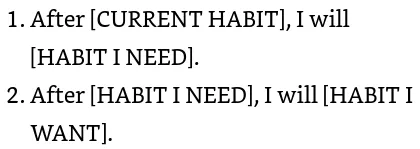
Figure 2: Temptation Bundling & Habit Stacking - Response – Make it Easy: James Clear argues that “our real motivation is to be lazy, and to do what is convenient (…) People will naturally gravitate towards the option that requires the least amount of work”. By making desired behaviors easy to do, you significantly increase the chances of those behaviors becoming a habit. This involves reducing the friction and thus minimizing the effort required to start a habit. Choose a running route that is easy to access from your place. If the weather or the distance is a barrier, start with a treadmill. Reduce obstacles that might discourage you from engaging in the desired action - in this case, running.
Image
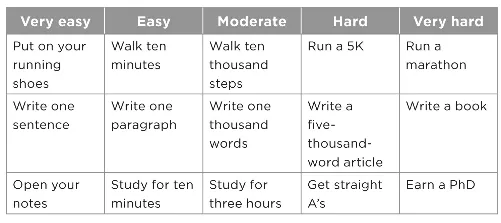
Figure 3: Map out your goals on a scale from "very easy" to "very hard" - Reward – Make it Satisfying: One of the most effective ways to reinforce a new habit is to make it satisfying. The pleasure of completing a task or receiving a reward makes us more likely to repeat the behavior in the future. Immediate rewards are particularly effective because they create a positive association with the habit. After your running session, eat a healthy snack, take a relaxing shower, or get a few minutes of downtime doing something you enjoy.
James Clear states: “The first three laws of behavior change – make it obvious, make it attractive, make it easy – increase the odds that a behavior will be performed this time. The fourth law of behavior change – make it satisfying – increases the odds that a behavior will be repeated next time”. That way, you create what the author refers to as “The Habit Loop”.
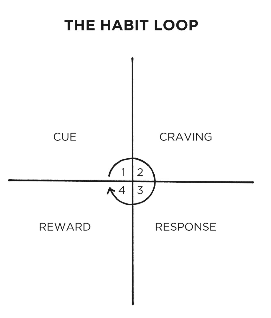
Figure 4: "The cue triggers a craving, which motivates a response, which provides a reward, which satisfies the craving and, ultimately, becomes associated with the cue”
Atomic Data Governance
Returning to what got us here in the first place and borrowing insights from “Atomic Habits”, we would like to explore an alternative route to Data Governance, focusing on small, consistent steps that can make the process more approachable and actionable. We typically recommend our clients to “simply get started” and approach Data Governance in a non-invasive way, embedding it within their existing business operations. For example, if you often encounter data issues in your daily job, start by initiating a process to log and monitor these issues. It will lay the foundation to build your business case. Apropos, we did already write an article on this topic called Implementing a Data Governance Program: Overcoming Reluctance to Change.
In the same vein, if you notice a gap in understanding business terminology among your stakeholders, creating a Business Glossary could help achieve uniform comprehension. Therefore, many of our clients are particularly interested in a Data Catalog, as they would like to better understand their data landscape and create a common layer of understanding.
With this in mind, let's apply the principles from "Atomic Habits" to implementing a Data Catalog, taking this example as a case in point:
- Cues – Make it Obvious: Following James Clear’s advice, our focus should be on designing the environment to naturally prompt the use of the Data Catalog. The crucial element of this step will be connecting the use of the Data Catalog to resolving daily data-related challenges. If finding or understanding the data is problematic, demonstrate how the Data Catalog directly addresses this issue. Sharing success stories where the Data Catalog has provided tangible solutions will help integrate it seamlessly into your organization’s data habits.
Capture the attention and start with the data that people already interact with frequently. This is about creating a clear and recognizable cue for the new habit. Also, ensure the Data Catalog is visible and accessible, perhaps through a single click from the intranet homepage or embedded within frequently used applications. Consider promoting the Data Catalog in regular meetings or through your communication channels, emphasizing its benefits in simplifying daily tasks.
This step will be all about raising awareness of the existence of the Data Catalog and its value in everyday use.
- Craving – Make it Attractive: You could be wondering how to make a Data Catalog appealing, and this might seem challenging at first. Yet, the key to generating interest is simplifying people’s lives. Start by working with a specific department or team to demonstrate the benefits of the Data Catalog. Show how it makes finding and understanding data easier than traditional methods, like navigating through numerous Excel files or various email chains.
Identify and engage early adopters to use some “peer influence” to evangelize the benefits of the Data Catalog. They will become your ambassadors in your future Data Governance efforts.
Use the “habit stacking” technique to insert the adoption of the Data Catalog into habits that are already performed. For instance, “After I attend the morning stand-up meeting, where I align on the day's priorities, I will take a moment to update some new data assets in the Data Catalog”.
Acknowledge contributions to the Data Catalog. Consider implementing gamification elements like badges or points to foster a sense of achievement and competition, making engagement more enjoyable and rewarding.
Another interesting strategy involves linking the Data Catalog usage to professional development opportunities, such as acquiring new data skills or gaining insights into different business areas.
Finally, the Data Catalog will be a great resource for new joiners. It will enable them to quickly assimilate knowledge about your data assets, the way they’re organized and used, who to contact in case of questions, and what are the various business terms they should quickly get familiar with.
At this stage, it is critical to ensure that the adoption and use of the Data Catalog meet several key needs: the simplicity of use and knowledge centralization, the sense of importance and purpose through acting as an evangelist for the tool, the support of personal growth and learning objectives, and the element of competition through gamification. These components are essential in creating an attractive and engaging environment around the Data Catalog.
- Response – Make it Easy: Having made the Data Catalog obvious and attractive, our next goal is to navigate the “path of least resistance” to encourage its use. Start by identifying the most critical data elements that your organization uses regularly. Do not attempt to catalog everything at once. Break down the Data Catalog implementation into manageable phases, starting with the most critical data and expanding gradually. This method reduces the feeling of being overwhelmed and clearly defines what to catalog next.
Next, it's important to ensure that the Data Catalog seamlessly integrates with your team's existing tools and processes, minimizing the learning curve and resistance to adoption. This is where Data Cataloging solutions like Zeenea are a great example. By separating the roles of data stewardship and exploration, Zeenea makes it more intuitive for the users to engage with the system. It provides a user-friendly interface that fits neatly within existing workflows, reducing resistance to new processes. Moreover, its on-demand training resources enable users to learn how to effectively manage data with ease, ensuring that support is available when needed.
Additionally, consider each step a user must take to interact with the Data Catalog, and search for any possibility of removing friction. Aim to simplify regular interaction with the tool. For example, explore possibilities for automating data entries and provide standardized templates for common data types. Ensure data owners & experts are well identified to enable quick contact and feedback, enhancing the overall user experience.
- Reward – Make it Satisfying: Finally, “one of the most satisfying feelings is the feeling of making progress”. You should use dashboards to display the status of data curation and the concrete benefits gained from using the Data Catalog, in terms of data management and literacy.
Make yourself a habit of sharing success stories that highlight the positive impact of the Data Catalog on projects or decision-making processes, reinforcing the value of contributing to and maintaining it.
Encourage user feedback on the functionalities of the Data Catalog and incorporate actionable suggestions, fostering a sense of ownership and community among users.
System Over Goals
What is important to keep in mind is rather than focusing on the final objectives, it is to focus on implementing a system. These initial steps help to establish a system for continuous improvement in your Data Catalog. By embedding Data Governance practices into the daily routines and existing workflows of the organization, you're not just setting a goal, but building a system that makes achieving that goal more likely.
Just as "Atomic Habits" emphasizes the importance of continuous, slight improvements, starting with these small steps allows for iterative refinement. As each step is implemented and its impact assessed, the process can be adjusted and expanded, fostering a culture of ongoing improvement.
To reinforce this system, let’s borrow one last concept from James Clear’s book: “The Habit Contract”. This concept introduces the idea of the “accountability partner” who can create an immediate cost to inaction. In the world of data, this concept is not unlike a “Data Contract”. In a decentralized data management approach, you can keep each other accountable by agreeing on a data contract. This artifact describes the agreements made about a dataset, with regards to schema, quality, ownership, ... Such a contract can add a “social cost” to any of our behavior, as we do care about the way others perceive us. When a Data Producer knows that other departments depend on the integrity of the data they provide, it naturally incentivizes adherence to these standards. It is not about the fear of repercussions alone; it is about the intrinsic motivation to maintain one's professional reputation and contribute to the collective trust in the organization's data ecosystem.
Conclusion
By bringing ideas from "Atomic Habits" into the world of Data Governance, we tried to show you a simple yet powerful truth: big changes come from small steps. Just like the small habits that improve our daily lives, tiny steps in managing data can lead to huge improvements in how our organizations work.
Our talk about the Data Catalog was just an example. Starting small can help us tackle big challenges in organizing and understanding our data better. This approach isn't new but using the ideas from "Atomic Habits" makes it feel novel and achievable as it provides a framework.
So, what's the next step? It's about acting, even if it's small. Every big journey starts with a single step. By focusing on small, practical steps, we can make Data Governance less daunting and more a part of our daily work routine. Let's start this journey today, making our data work better, one small step at a time. Are you ready to take the first step? Don’t hesitate to reach out.
References
James Clear, Atomic Habits: An Easy & Proven Way to Build Good Habits & Break Bad Ones (First published October 16, 2018 by Avery)

